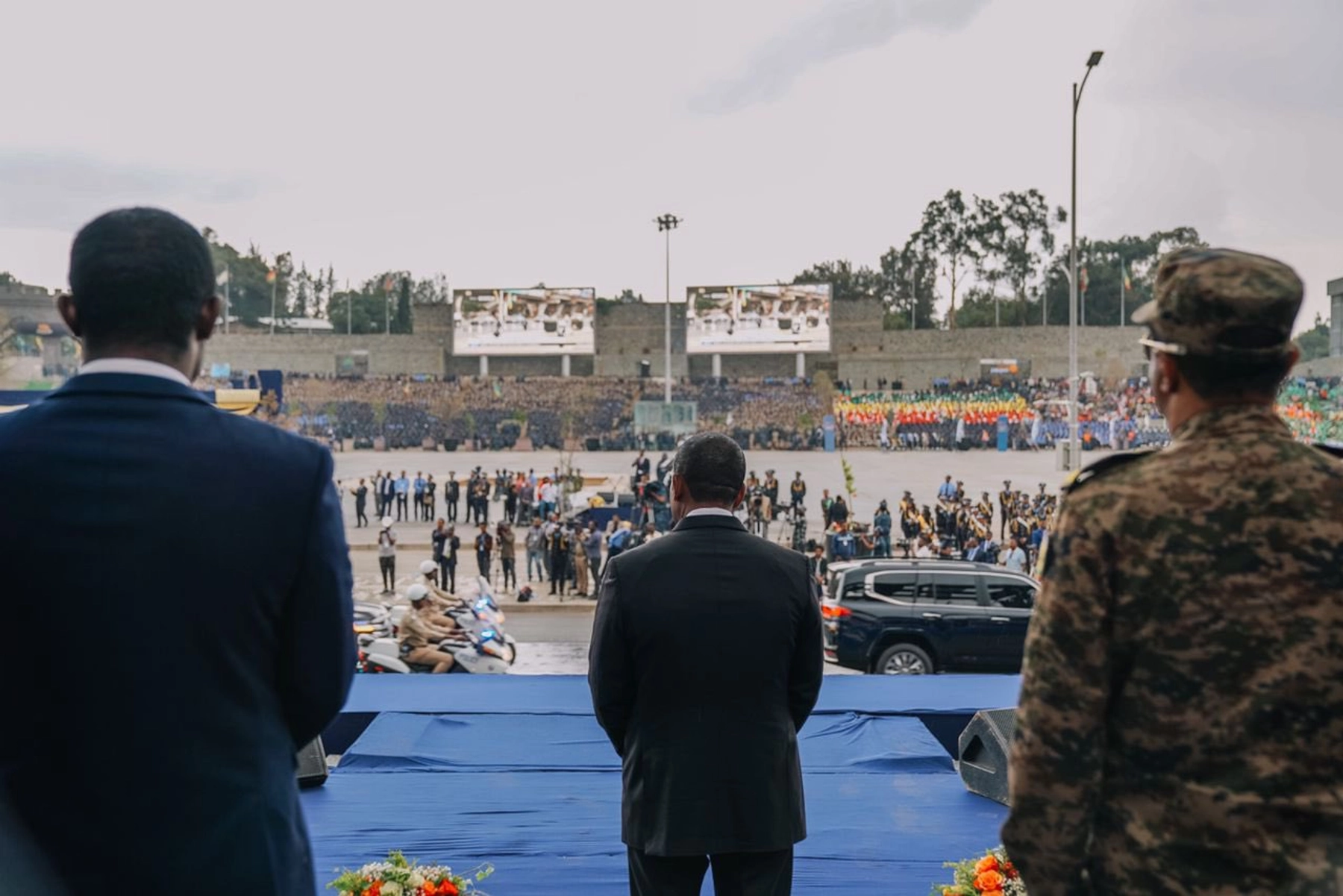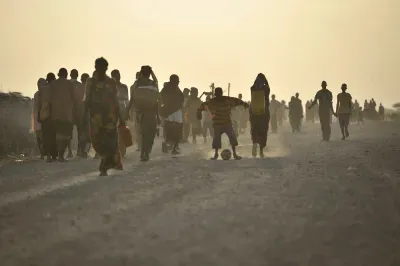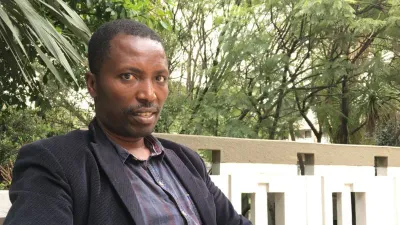Shifting Political Alliances and the Enigma of Peace in Ethiopia

PM Abiy Ahmed attending a recognition ceremony for the Federal Police Force in acknowledgment of their service and contributions in Addis Ababa, June 5, 2022. Photo/PM Office.
The political crises in Ethiopia are rooted in competing visions of state, identity, and citizenship. It is ingrained in the political contradictions between a colonial and a settler-colonial type of state building on the one hand, and the forces of emancipation, liberation, or crudely speaking, those demanding the right of self-determination, on the other. It is a contradiction between the aspirations of imperial hegemony and self-rule; between aspirations for political, economic, and socio-cultural domination vs visions of establishing a free society. Like other parts of the world where wars of decolonization and liberation were fought, liberation movements and political organizations were established in Ethiopia to dismantle such imperial imaginations and institutions.
Nevertheless, as the political scientist and chairman of the Oromo Federalist Congress (OFC), Professor Merera Gudina articulates, it is the tension between these competing nationalisms that still haunts the peace and stability of the country, leading to cyclical conflicts, wars, and violence. Indeed, although the past ten years witnessed a shift in political alliances and power configurations that seemingly disrupted longstanding relationships and formed short-term partnerships, the country remains in a state of turmoil. Focusing on three recent instances of alliance formations, this article examines why such experiments often fail to produce lasting peace, instead perpetuating violence and cyclical wars.
The short-lived “Oro-Mara” euphoria (2017-2018)
With the logic of “the enemy of my enemy is my friend,” Oromo and Amhara politicians, within the EPRDF coalition, forged an informal alliance against the TPLF, the dominant party within EPRDF, around 2017. Framed as “Oro-Mara,” this alliance was used by Abiy Ahmed as a political and discursive construction in mobilizing members of the two national groups to consolidate power. Apart from outflanking the TPLF and helping Abiy Ahmed to ascend to the helm of power, it failed to resolve the historical contradictions between the Amhara and Oromo.
Rather, fundamental differences that persistently cause tension between the two groups, such as the politics of historical memory, the issue of Finfinne (Addis Ababa), language, and questions of self-determination, remained unresolved. Abiy’s attempts to install imperial visions of the state, together with the rise of Amhara nationalism and its claim over many parts of Oromia, have dissipated the optimism that some Oromo activists had about this alliance. By 2019 and early 2020, after marginalizing the TPLF, Abiy abandoned the “Oro-Mara” narrative altogether, as did the Oromo and Amhara political elites who once popularized the buzzword.
A Coalition of Retribution: the Prosperity Party-Amhara nationalists’ alliance (2019-2022)
Abiy Ahmed and his Prosperity Party (PP) initially gained support from Amhara nationalists mainly because of the Prime Minister’s political agenda, which aimed at dismantling the multinational federal system and forging a centralized system and a unified Ethiopian identity. PP exploited Amhara nationalists’ discontent with the previous TPLF-dominated regime and the federal system they blamed for reducing Ethiopian identity to ethnonationalism. Amhara elites, both in the ruling Prosperity Party and the opposition alike, cherished Abiy’s discourse of creating a “greater Ethiopia.”
Inspired by territorial claims and politics of vengeance, Amhara militias, notably Fano, actively participated in the Tigray war (2020-2022). Human rights organizations documented that Amhara forces and their allies in the Ethiopian army massacred Tigrayans in revenge attacks, pillaged their properties, occupied their land and displaced the people in the form of ethnic cleansing. At the end, they succeeded in occupying fertile lands in Western and Southern Tigray.

According to one report, the political marriage ended, and the region is now home to a full-blown armed uprising against the very same government. The immediate cause of the split between Abiy’s Prosperity Party and Amhara nationalists was the November 2022 Cessation of Hostilities Agreement (CoHA) signed between the federal regime and the Tigray People’s Liberation Front (TPLF), an accord the leaders of the ongoing Amhara armed uprising denounced as a “pact of betrayal.” At the heart of this so-called pact was Abiy’s commitment to restore the constitutional order, including the return of territories like Walkait and Rayya to Tigray—lands Amhara forces seized during the war. As a coalition driven more by vengeance than shared political vision, it was hardly surprising that the former allies turned their guns on one another, transforming the region into yet another theater of bloodshed.
Oro-mara 2.0?
Amhara and Oromo nationalists have clear political contradictions and differences in historical memories, and visions of the state, which are fundamentally irreconcilable. Attempts to mediate both dichotomies were only possible under the multinational federalism arrangement (1995-2018).
During this period, despite limitations in implementing the constitution, the right to self-rule served as a guarantee and covenant for each nation in Ethiopia to co-exist within the federal architecture. However, the post-2018 political landscape is quite different. Firstly, unlike in the pre-2018 period, Amhara nationalism has become a militant nationalism, reaching the level of claiming territories in other sovereign regional states such as Benishangul Gumuz, Oromia, and Tigray.
Secondly, while the TPLF-dominated EPRDF was committed to safeguarding the federal architecture, the current Prosperity Party allies with Amhara nationalists to dismantle it. A scenario that pitted Amhara and Oromo nationalists against each other. Over the last five years, the Amhara militia and Fano crossed into the East Wallaga, Horro Guduru Wallaga, North Shawa and East Shawa zones of Oromia Regional State and repeatedly attacked civilians, killed hundreds, displaced hundreds of thousands, majorly disrupting socio-economic activities. These attacks are part of Amhara nationalists’ political agenda of creating “greater Amhara” through the incorporation of territories bordering the Amhara region.
In this polarized environment, there have been calls for a re-approach between Amhara and Oromo nationalists, including with Fano, primarily voiced by diaspora Oromo activists, scholars, and politicians.
There are two fundamental flaws in this new alliance formation. First and foremost, any alliance forged based on zero-sum tactical expediency, without any clear goal or strategy, is bound to fail. Abiy’s regime has been brutally killing, displacing, and dispossessing Oromos over the last seven years. Likewise, Amhara nationalists have a similar agenda of violently appropriating Oromo lands and displacing the people. We witnessed this over the last couple of years both in practice and at discursive levels – attacks by Amhara forces in Oromia and narratives from these forces in “re-claiming” territories within Oromia. A key question one might ask is, why is it not possible to label both forces as adversaries to the Oromo national interest and shape the struggle accordingly? Some might argue that it is not strategically wise for the Oromo to launch a horizontal and vertical struggle simultaneously, but these assertions are not plausible. It is not convincing because the Oromo struggle is primarily a question of ensuring the sovereignty (Abba Biyyummaa) of the people, and any threat to this should be resisted – whether it comes from the state or sub-state levels.
Secondly, seeking an alliance with a group that fundamentally opposes Oromo national interests diminishes the struggle to a matter of “power struggle,” thus validating the regime’s portrayal of the movement in that light. In other terms, partnering with Amhara forces—regardless of whether the collaboration is tactical or strategic—compromises the Oromo national interest.
Where is the Faultline?
A critical analysis of the three “alliance” formations over the last decade reveals that these coalitions emerged either for a short-term tactical gain or out of political vengeance rather than to find a genuine path to peace and democratization. Abiy used the “Oro-Mara” alliance to consolidate his power. Amhara forces tactically used their alliance with the regime to fulfill promises made to their base by “retaking” Walkait and Raya. Nevertheless, both approaches have failed in moving the country to peace and stability.
What is the way out?
Currently, the country is mired in multidimensional crises, searching for a viable path to peace more urgently than ever before. At the core of these crises lies a political agenda that promotes an imperial vision. This vision is shared by both Abiy and Amhara forces and was demonstrated in their alliance during the Tigray war. In the spectrum of alliance formation, a meaningful coalition can only be established between those who experienced similar historical memories of marginalization and struggle for their right to self-determination. Amhara and Tigrayan forces that believe in the right to self-determination can also possibly join the alliance. Furthermore, Oromo activists and politicians must exercise caution to avoid making the same errors of placing individuals and groups who are fundamentally opposed to Oromo national interests in positions of authority. This position should not, in any way, be construed as considering Abiy’s regime the lesser evil. Both camps are a threat to Oromo national interests and must be resisted with equal resolve. Any quest for peace in Ethiopia should put the sovereignty of the nations and nationalities at the center and refrain from imposing imperial visions and authoritarian statecraft.
We need your support
We trust you found something of value in this article. If so, we kindly ask you to consider helping Curate Oromia continue its work.
If you believe in the importance of independent voices and honest reporting, we invite you to support our efforts through our GoFundMe campaign.
Every contribution, however small, goes directly to our writers and the expansion of our reach.
Thank you for your support.



